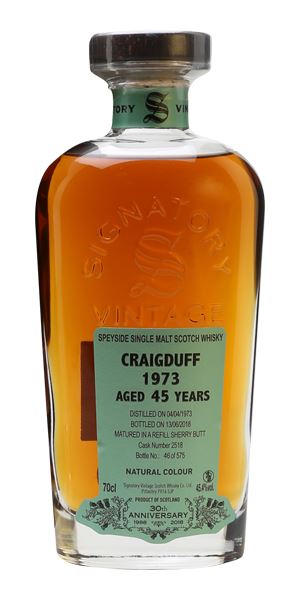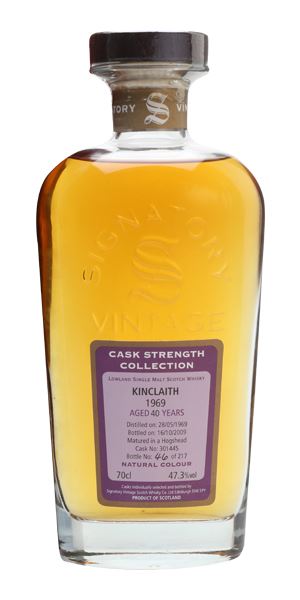-
Craigduff 45 Years Old, Distilled 1973, Signatory 30th Anniversary (Signatory)
Score
91

- Price band
-
£ £ £ £ £
- ABV
- 45.4%
- Production type
- Single malt whisky
- Region
- Speyside
- Flavour camp
- Fruity & Spicy
- Nose
I never really detected peat in any Craigduff I tried, and it’s the same story here. Rather, there’s just bags of roasted nuts, dates, quince, fig jam and herbal medicinal balms. Some exotic teas, red fruits, wood spices and mirabelle. Superbly exotic, simmering and lush. A few cereal touches such as fruit muesli emerge with time. Goes on with lime peel, papaya and assorted dried exotic fruit chunks and banana chips. Superb.
- Palate
No peat, but a wonderfully syrupy and plush texture. Tropical fruit in liquid satin form. Quince, Darjeeling tea, cocoa powder, white chocolate and the warmth of paprika. Treads a lovely balance between spice and grip from the wood and more ethereal and complex elements, such as dried herbs and exotic fruits from the distillate. Warming, soft, complex and extremely pleasurable.
- Finish
Getting sootier, more mentholated, waxier and a bit more peppery with green pepper, vapour rub and chamomile.
- Conclusion
Not sure what influence the peat really had here; perhaps it was more vivid in youth? Instead what remains is a beautifully structured, elegant and resilient old-school Speyside whisky. Lots of tropical inflections buoyed up by just the right nibble from the oak. The very definition of great older single malt and not at all tired or flabby.
- Right place, right time
Smuggling barrels of peaty water out of Stornoway at 3am, you toss a coin over to decide whether to head for Glen Keith or Strathisla...

- Price band
-
£ £ £ £ £
- ABV
- 47.3%
- Production type
- Single malt whisky
- Region
- Lowland
- Flavour camp
- Fragrant & Floral
- Nose
There’s a whiff of something Irish about it, with this sudden burst of green banana, trampled ferns and things like petrichor, root vegetables and lamp oil. Lemon oils, fabric and plain cereals all follow, with hints of chalk and ripe melon as well. A rather fascinating nose that offers some surprisingly fresh fruits, along with oilier and more mechanical aspects as well. Notes of strawberry sweeties, metal polish, citronella and verbena. I find it very good and aromatically quite complex – not to mention, entertaining.
- Palate
Again, it’s immediately reminiscent of some very old pure pot Irish whiskey, what with these rather glowing, plush cereal tones. Some sweetness from honeyed porridge, more melon, green banana again, a slight warmth of white pepper, some coal dust and hints of mustard powder, camphor and waxed canvas. There’s a lightness to it, which speaks of long maturation in pretty dead wood, but it works well here as there’s no sense of fatigue about it. A very light mineral oil note and some brief salinity towards the finish.
- Finish
Medium and rather light. Lots of lemon peel, hints of lighter fluid, baking powder, ink, wormwood and furniture polish. Unusual, but very good.
- Conclusion
There’s a definite Irish accent to this one, which makes it distractingly entertaining and funny. However, from a more academic perspective, it’s also a very fine dram in its own right. The cask feels rather dead, which I think has served it well as there’s still rather a lot of freshness about it: cereals, fabric, fruits, etc. Fascinating and pleasurable to taste such an obscure and historic name.
- Right place, right time
There’s an abundance of curiosity, but the blind tasting just got a lot more expensive.
Rare Ayrshire 44 Years Old, Distilled 1974, Signatory 30th Anniversary (Signatory)
Score
93

- Price band
-
£ £ £ £ £
- ABV
- 53%
- Production type
- Single malt whisky
- Region
- Lowland
- Flavour camp
- Fruity & Spicy
- Nose
Fat, punchy fruits in jellied form. Bags of gooseberry, mango, acacia honey, quince and a multitude of different dried herbs. There’s also waxes, almonds, rosewater, eucalyptus oils, menthol tobacco and pine cones. It’s one of these very old whiskies that has become exotic, super concentrated and extremely complex as a result. Fennel, camphor, hessian, ointments, ink, very old herbal liqueurs... you could really go on and on listing tiny wee aromas. With water, it develops more towards cedar wood, unlit cigars, pine resin and face cream. Still lots of resinous and nervous fruity notes.
- Palate
Damn! The palate is far from tired or overly woody. This is superbly complex and an extraordinarily concentrated, punchy old whisky. Swollen with dried tropical fruit chunks – mango, papaya, pineapple and banana. There’s also fruit loaf full of date and sultana, Darjeeling tea, lime leaf, liquorice, lemon cordial, jasmine and some wonderful old Sauternes. Silky in texture but also direct, spicy and chiselled in profile as well. It shows such an unusual combination of muscle and power on one hand, and complexity and grace on the other. Water elevates the complexity even further and brings a rather astonishing spiciness. Also treacle, sunflower seeds, fruit-scented tobacco and leather.
- Finish
Long, extremely resinous, herbal, texturally oily; garden fruits baked in syrups and spices, herbal medicines, waxes... stunning.
- Conclusion
What a stupendous old whisky. You can imagine when nosing that it might all fall apart on the palate, but instead it just keeps on getting better and better. By quite some distance this is the best Ladyburn/Rare Ayrshire I’ve ever tasted. Cinematic in scope and offers up complexity, balance and concentration in almost embarrassing abundance.
- Right place, right time
Sitting in an extremely plush library, writing numerous letters to William Grant executives requesting that they make more of this magical old ‘Balvenie of the Lowlands’.

For this week’s rare whisky tastings, Angus MacRaild has selected three bottlings from Signatory Vintage that represent both scarcity and obscurity in Scotch single malt whisky: examples from Craigduff, Kinclaith and Rare Ayrshire (mostly commonly known as Ladyburn). All are names rarely seen these days, and are often hard to tick off the tasting list.
First up is Craigduff. The jury still remains out on whether this experimental peated malt was made at Strathisla or Glen Keith distillery. Chivas insists it was Strathisla, while others – notably Andrew Symington, who has been responsible for most of the extant bottlings – say it was distilled at neighbouring Glen Keith. Stories abound about peated water being transported from the Western Isles in drums and being subsequently concentrated and added to the wash distillation. While the exact origins of Craigduff may be in doubt, MacRaild finds this particular bottling a ‘stunning’ example of older Speyside single malt, which has retained balance, complexity and freshness.
Following on from the mysterious Craigduff is the rarer, yet better understood, Kinclaith. Produced for just shy of 20 years, Kinclaith was a blending malt distilled at Glasgow’s Strathclyde grain distillery between 1958 and 1977. The vast majority of it went into Long John blended Scotch, and although a few casks have popped up over the years it remains one of the scarcest names in Scottish single malt whisky. MacRaild finds this example nodding curiously in the direction of older Irish whiskeys – a phenomenon he credits to maturation in a very tired cask. After 40 years of ageing, this allows a satisfying glimpse into the Kinclaith distillery character.
Finally in this session of lost names is Rare Ayrshire, or as it is also known, Ladyburn. Another malt distillery situated within a grain plant, this time at William Grant & Sons’ Girvan distillery, Ladyburn existed for just nine years between 1966 and 1975. There have been more than a few bottlings under the Ladyburn and Rare Ayrshire labels over the years, though as MacRaild notes, this is by some distance the best he’s tasted.

